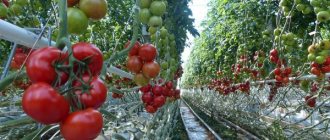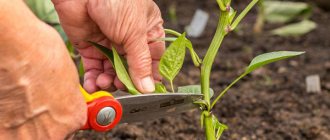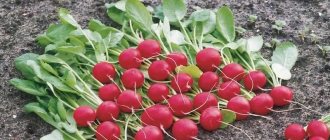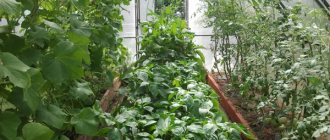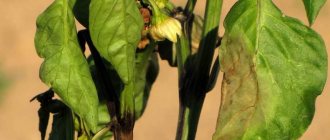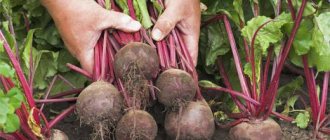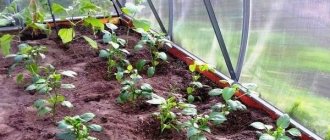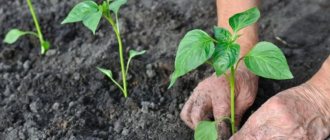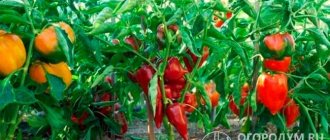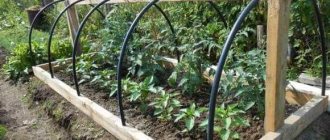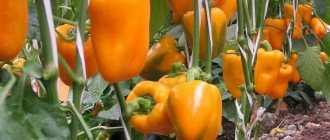| 22652 | 3 | Print Click Print or CTRL+P to print the page |
Peppers in a greenhouse have several degrees of ripeness. To obtain a good harvest of peppers in a greenhouse, care must be taken to ensure that the fruits ripen early. But in central Russia, it is not always possible to fulfill our plans, since daylight hours and weather conditions do not allow culture to actively develop.
General information
Peppers ripen faster if the bushes are located at a distance from each other. In this case, the plants receive the optimal amount of light. If you purchased tall varieties, it is better to place them in the central part of the greenhouse; low-growing varieties should be placed along the edges of the building. Unthickened plantings are easier to ventilate and the risk of fungus is minimized.
The technical ripeness of peppers means that they should be picked slightly unripe. Such fruits have a yellowish or greenish color, tolerate transportation well and are stored for a long time.
Indirectness ratio
Pepper plants are very light-loving. When shaded, buds and ovaries fall off. Yellowing of the leaves is noted, vegetative organs become fragile and very brittle. With a lack of light, plants generally do not enter the reproductive period of life. The optimal illumination for pepper plants is 30-40 thousand lux.
Pepper is especially sensitive to light intensity during the formation of generative organs. During this period, the seedlings correspond to the phase of 3-4 true leaves, and the light level should be at least 5 thousand lux.
For normal development, plants require a short (12-14 hour) day. Moreover, various varieties begin to respond to short days only from 20-30 days of age. Before this period, a long day is beneficial for plants; it accelerates their growth. A short day also has no effect on plants older than 60 days. A short day accelerates the development of plants, causes earlier flowering and earlier formation of fruits. However, the effect of a shortened day appears only under conditions of high air and soil temperatures (above 15°C). To regulate day length, greenhouses and greenhouses with seedlings are covered with roofing felt, mats, and special shields.
Late-ripening varieties respond more strongly to shortened days than early-ripening varieties originating from temperate latitudes.
Determination of maturity
Peppers in a greenhouse have several degrees of maturity. There are 2 main varieties: biological and technical ripeness.
Biologically ripe peppers differ in color. She may be:
- orange;
- red;
- yellowish;
- brown;
- lilac.
Ripe peppers cannot be stored for a long time. The maximum shelf life is 2 weeks. Therefore, the vegetable must be immediately removed and processed.
Bags with a thickness of more than 120 microns can be used as storage containers
The technical ripeness of peppers means that they should be picked slightly unripe. Such fruits have a yellowish or greenish color, tolerate transportation well and are stored for a long time if optimal conditions are created for this.
When the vegetable is picked unripe, it can be stored for more than 2 months. It is better to place the fruits in the refrigerator or cellar.
You can also use wooden boxes with newspaper or paper on the bottom. Peppers should be laid out in layers, sprinkled with sand. To increase shelf life, each vegetable can be wrapped in thick paper.
Do Russian and Ukrainian troops have any casualties on February 27?
Yesterday, February 26, late in the evening, Ukrainian President Vladimir Zelensky summed up the first day of military clashes, which the Russian Federation calls a “special operation to protect Donbass.” He reported that 137 Ukrainian citizens died during the day, 10 of them were officers, and 316 people were injured. Among the dead were 13 border guards guarding Zmeiny Island.
On the Russian side, data on the dead is not disclosed. Moreover, the Russian Ministry of Defense declares that there are no losses at all. And the number of casualties among the Russian army can only be judged by reports from the Ukrainian side and journalists.
These data vary greatly - from “three times more than the losses of Ukraine” to “more than a thousand Russian military personnel.”
Harvest dates
Peppers in the greenhouse are harvested based on technical or biological maturity. Biological maturity involves the achievement by the fruit of all the characteristics inherent in the fruit species - color, size, shape. Technical ripeness involves only the formation of the fruit. Usually it occurs after 2 months. The interval between the biological and technical maturity of pepper is a month. Sometimes it can reach 20 days - it all depends on the variety.
We also invite you to learn about the basic rules and methods of watering greenhouse peppers.
Biologically ripe peppers differ in color. It can be: orange, red, yellowish, brown, purple
How to tell if a pepper is ripe
Vegetable growers and gardeners use various methods to determine the degree of ripeness of sweet peppers. These include:
- color - depending on the variety, it should be red, orange-yellow, purple or brownish;
- shape and size - must exactly correspond to the characteristics declared by the manufacturers of the seed or hybrid;
- structure – the flesh of a ripe pepper should be juicy, elastic and crispy; when you touch the vegetable, you will notice a characteristic crackling sound;
- smell – ripe bell pepper has a fresh, pleasant aroma without foreign impurities.
When harvesting sweet peppers, you need to take into account the stages of maturity. Technical maturity, depending on the variety, occurs 35-45 days after the start of the flowering period. The pepper already corresponds to the parameters of a ripe fruit, but differs in color - it is greenish or lemon yellow. Unripe vegetables are well stored and can withstand long-term transportation without loss.
Sweet pepper harvested at the stage of biological maturity cannot be stored for long. After just 10 days, the fruits completely deteriorate, causing rotting of other vegetables located nearby.
Ripe peppers are best consumed, processed or sold immediately. The only exception is hot pepper, which is harvested only after complete physiological ripening.
Harvesting Rules
The first harvest can be obtained in mid-August, and the last one before winter. Peppers are harvested mainly when they are in the technical and biological stage of ripening. At this time, the optimal amount of useful elements is concentrated in the fruits, including vitamins, salts, and sugar. You can tell when it’s time to start picking peppers simply by the sound: ripe vegetables begin to crackle.
If you collect fruits at the technical stage of maturity in a greenhouse, you need to act selectively. Harvest vegetables at intervals of 7 days. Peppers should be trimmed along with the stalk. This way you will increase the shelf life of vegetables, and the pepper will retain its beneficial properties.
What rules should be followed during harvesting?
- You should not damage the peppers, as they are fragile by nature.
- If you delay harvesting, crop growth may stop.
- During the growing season, an average of 4 fruit harvests can be harvested.
For long-term storage, you need to choose the strongest peppers. The fruits should not have mechanical damage - dents, cracks
When frost hits, you should collect the remaining peppers and get rid of vegetables that are unsuitable for storage. Sort the fruits by ripeness level. This way you will understand how long it will take for certain vegetables to ripen.
Cleaning nuances
Environmental conditions play an important role in fruit ripening. Vegetables growing in open beds and in greenhouses have different harvest times.
In the greenhouse
Frosts are not harmful to fruits grown in a greenhouse. In closed beds, vegetable growers often set harvest dates themselves. The season may end with the onset of a consistently cold period. However, it is worth considering that a decrease in temperature indicators affects the plant, inhibiting its development and fruit ripening.
In the open ground
In open garden beds, weather conditions play an important role in the ripeness of vegetables. The plants are heat-loving and do not tolerate frost, so the fruits should be harvested before the first cold snap.
Important! Delaying the first harvest can lead to stunted plant growth, which will slow down the development of new fruits.
Storage periods and rules
Pepper, like many other vegetables, has low shelf life. If stored incorrectly, it will rot in two days. If properly stored, these vegetables can remain in good condition for a month longer than eggplants or tomatoes. For long-term storage, you need to choose the strongest peppers. The fruits should not have mechanical damage - dents, cracks.
Storage ability also depends on the type of pepper. If you choose the right type of vegetable, it will last a long time.
Bags with a thickness of more than 120 microns or boxes can be used as storage containers. They transport and sell vegetables in plastic packaging. There should be a perforated membrane on the side wall of the container.
Storing in polyethylene has several advantages: it does not allow air to pass through, and carbon dioxide is formed inside the bag, displacing oxygen. In addition to polyethylene, the fruits can be wrapped in paper.
Storing in polyethylene has several advantages: it does not allow air to pass through, and carbon dioxide is formed inside the bag, displacing oxygen. In addition to polyethylene, fruits can be wrapped in paper
It is best to store vegetables in the basement. First, they are laid out in boxes and baskets or bags in 2 rows, and then placed on shelves. It is important that the ambient temperature is 10 degrees and the humidity is about 85%. Vegetables wrapped in paper are well preserved for 1.5 months without loss of quality and taste.
Pepper fruits absorb foreign odors well, so it is important that the storage room does not smell of anything unnecessary. It is good if the pepper is placed away from other vegetables. The container should also not smell and should be as clean as possible.
If it is not possible to store vegetables in the basement, you can place them in the refrigerator. In this case, the storage duration will be reduced, but if the humidity reaches 80% and the temperature is 9 degrees, the peppers can last until the next month without spoiling.
The fruits can be used both fresh and processed. Pepper can be stewed, frozen, dried, canned and boiled, and can be used to make paste, puree and caviar. The fruits are often canned. Frozen and dried vegetables can be used to prepare side dishes and soups, and they can also be used as snacks.
You may also be interested in the article in which we talk about the reasons for the curling and wilting of greenhouse pepper leaves.
Relationship to temperature
Pepper is a highly heat-demanding crop. Its seeds begin to germinate at temperatures not lower than 13°C (only certain varieties can produce single shoots at 10°C). But at 13-15°C, the processes of swelling and awakening of seeds to growth are extremely slow, and seedlings appear only on the 18-25th day after sowing, and sometimes later. Only warming up to 25°C ensures uniform germination of seeds and emergence of seedlings in 7-9 days.
The optimal air temperature for 4-7 days after emergence of seedlings during the day is 14-16 ° C, at night - 8-10 ° C, and after hardening of seedlings before hardening of seedlings during the day in sunny weather - 25-27 ° C, in cloudy weather - 18 -20°C, at night - 13-15°C. Plants up to 50-60 days old are especially sensitive to temperature changes.
Subsequently, in cloudy weather or in strong shade, pepper grows and develops best at a temperature of 20-22°C, and on clear sunny days - at about 30°C.
During the fruiting period, older plants can develop and accumulate yield at a temperature of 15-18°C. However, further cooling has a negative impact on the formation of generative organs and flowering, and at 10-13°C, growth processes practically stop. Under these conditions, the flow of water into the roots is significantly impaired, metabolism is disrupted, and plant death often occurs.
Pepper plants are very sensitive to sub-zero temperatures. They die in frosts of -0.3...-0.5°C. Excessively hot weather is also unfavorable for them, especially in combination with a lack of moisture in the soil and air. At temperatures above 35°C, plant suppression and buds and flowers fall off. The conditions of summer heat during the flowering period are especially unfavorable.
Temperature conditions are closely related to light intensity. In low light conditions (cloudy weather, night), the air temperature should be lower than on clear sunny days.
Spicy peppers are more heat-loving than vegetable ones. It grows slowly, so it is later ripening. Frosts, even small ones, are destructive for him. Its highest yields are obtained in areas with an average daily temperature above 17°C (the absolute minimum) with a total temperature of 3000°C or more. Early ripening varieties require 2600°C, mid-ripening varieties require 2800-3000°C, the sum of temperatures above 10°C.
Forming peppers in a greenhouse (video)
After harvesting in the greenhouse, vegetables must be stored. This is not easy to do, since the shelf life of the fruit is often short. But, if you correctly collect the fruit at the technical or biological stage of ripening, select the temperature and humidity conditions in the storage room and wrap each fruit in paper, the shelf life can be increased.
+1 Nina 06.11.2015 00:46 Despite the capricious nature, sweet peppers have long become a welcome guest in my garden. I grow different varieties of them in a film greenhouse. At the end of July, the first peppers began to sing on the bushes, and in August, the harvest was amazing. I made a lot of different preparations from it, even froze it both whole for stuffing and already cut into strips. When in season, I added fresh pepper to salads, soups, borscht, and vegetable stews, made delicious sauces, and stuffed them with both minced meat and vegetables.
Quote
+1 Zinaida 11/27/2015 5:02 pm There is no doubt that pepper has become a favorite and healthy vegetable for everyone. I always have the question of how to preserve it longer. Every year I grow a late variety of red pepper; it doesn’t sit in the refrigerator for more than a month. Cellar storage has become a new thing for me, it’s worth a try.
Quote
0 Sofa 11/28/2015 12:20 My peppers don’t ripen all at once, they ripen gradually.
The first fruits are used in salads, and when there are a lot of ripe fruits, I can them. Before frost, many unripe peppers remain on the bushes. I tear them off, put them in boxes and lower them into the cellar. Thus, we eat fresh pepper for another month and a half. Quote
When is the best time to shoot?
The varietal characteristics of pepper determine its ripening period. Bitter and sweet bell peppers differ not only in appearance and taste, but also in the nuances of harvesting. If you remove the pepper at the wrong time, it may not have the best taste.
Hot pepper
Hot peppers can only be picked when they are fully ripe. If you remove it earlier, the fruit will not be spicy enough, since it acquires this taste quality only on the bush. The riper the pepper, the hotter it is.
Sweet (Bulgarian)
Each variety has its own ripening period. Sweet peppers can be harvested after reaching technical maturity - the fruit can ripen outside the garden during storage.
The situation in Ukraine at the last hour: news from the Russian Ministry of Defense
At 05:00 Moscow time, President of the Russian Federation Vladimir Putin announced the start of a special operation on Ukrainian territory. According to him, Russia’s main goals are to demilitarize and denazify Ukraine. The head of state announced his decision on TV, addressing the Russian people. RIA Novosti reports about what is currently happening on Ukrainian territory.
On the third day, the Russian army approached Kyiv. On Solomenka, in the area of Shulyavka and the Zoo, in Vasilkov there are battles for military units, a railway station, an airfield and other points.
Britain, the EU and the US have imposed sanctions against Putin and Lavrov. The Chechen National Guard is sent to Ukraine on the orders of Kadyrov. Russia blocked a UN Security Council resolution condemning the military operation.
Almost 500 Ukrainian Armed Forces military personnel voluntarily surrendered
On the morning of Sunday, February 27, the Russian Ministry of Defense announced the detention of 471 Ukrainian soldiers near Kharkov, Interfax writes, citing the department.
“Yesterday in the Kharkov region, the 302nd anti-aircraft missile regiment of the Ukrainian Armed Forces, equipped with Buk M-1 air defense systems, voluntarily laid down their arms and surrendered. 471 Ukrainian servicemen were detained,” said official representative of the Russian Ministry of Defense Igor Konashenkov.
According to Konashenkov, the detainees were provided with the necessary assistance. After completing the documents, they will be sent to their families.
Negotiations with Ukrainians should begin soon in Minsk
The Russian delegation has already arrived in Belarus for negotiations with the Ukrainians, presidential press secretary Dmitry Peskov told reporters. According to him, the delegation included representatives of the Ministry of Foreign Affairs, the Ministry of Defense and other departments, including the presidential administration, RIA Novosti writes.
“The Russian side is already ready for negotiations in Gomel, now we are waiting for the Ukrainians,” Peskov told RIA Novosti.
The Belarusian Foreign Ministry, for its part, noted that it had prepared everything necessary for the meeting and was now dealing with protocol issues.
At the same time, President of Ukraine Vladimir Zelensky said that Warsaw, Budapest or Istanbul, but not Minsk, could become the negotiation platform.
In recent weeks, the situation in Donbass has seriously deteriorated: Kyiv concentrated most of the army on the contact line and intensified shelling of the DPR and LPR, using equipment prohibited by the Minsk agreements. Due to the threat of invasion by Ukraine, the authorities of the republics began evacuating women, children and elderly people to Russian regions, declared general mobilization, and on February 19 asked Russia to recognize their independence.
